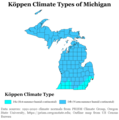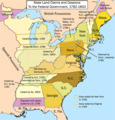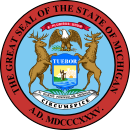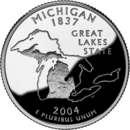Portal:Michigan
The Michigan Portal  Michigan (/ˈmɪʃɪɡən/ MISH-ig-ən) is a state in the Great Lakes region of the Upper Midwest region of the United States. It borders Wisconsin to the northwest in the Upper Peninsula, and Indiana and Ohio to the south in the Lower Peninsula; it is also connected by Lakes Superior, Michigan, Huron, and Erie to Minnesota and Illinois, and the Canadian province of Ontario. With a population of nearly 10.12 million and an area of 96,716 sq mi (250,490 km2), Michigan is the 10th-largest state by population, the 11th-largest by area, and the largest by area east of the Mississippi River. Its capital is Lansing, and its largest city is Detroit. Metro Detroit is among the nation's most populous and largest metropolitan economies. The name derives from a gallicized variant of the original Ojibwe word ᒥᓯᑲᒥ (mishigami), meaning "large water" or "large lake". Michigan consists of two peninsulas. The Lower Peninsula resembles the shape of a mitten, and comprises a majority of the state's land area. The Upper Peninsula (often called "the U.P.") is separated from the Lower Peninsula by the Straits of Mackinac, a five-mile (8 km) channel that joins Lake Huron to Lake Michigan. The Mackinac Bridge connects the peninsulas. Michigan has the longest freshwater coastline of any political subdivision in the United States, being bordered by four of the five Great Lakes and Lake St. Clair. It also has 64,980 inland lakes and ponds. Michigan has the second-most water area of any state, behind only Alaska. The area was first occupied by a succession of Native American tribes over thousands of years. In the 17th century, French explorers claimed it as part of the New France colony, when it was largely inhabited by Indigenous peoples. French and Canadian traders and settlers, Métis, and others migrated to the area, settling largely along the waterways. After France's defeat in the French and Indian War in 1762, the region came under British rule. Britain ceded the territory to the newly independent United States after its defeat in the American Revolutionary War. The area was part of the larger Northwest Territory until 1800, when western Michigan became part of the Indiana Territory. Michigan Territory was formed in 1805, but some of the northern border with Canada was not agreed upon until after the War of 1812. Michigan was admitted into the Union in 1837 as the 26th state, a free one. It soon became an important center of industry and trade in the Great Lakes region, attracting immigrants in the late 19th and early 20th centuries from many European countries. Immigrants from Finland, Macedonia, and the Netherlands were especially numerous. Migration from Appalachia and of Black Southerners as part of the Great Migration increased in the 1930s, with many settling in Metro Detroit. Although Michigan has developed a diverse economy, in the early 20th century it became widely known as the center of the U.S. automotive industry, which developed as a major national economic force. It is home to the country's three major automobile companies (whose headquarters are all in Metro Detroit). Once exploited for logging and mining, today the sparsely populated Upper Peninsula is important for tourism because of its abundance of natural resources. The Lower Peninsula is a center of manufacturing, forestry, agriculture, services, and high-tech industry. (Full article...) Entries here consist of Good and Featured articles, which meet a core set of high editorial standards.
The Toledo War (1835–36), also known as the Michigan–Ohio War or the Ohio–Michigan War, was a boundary dispute between the U.S. state of Ohio and the adjoining territory of Michigan over what is now known as the Toledo Strip. Control of the mouth of the Maumee River and the inland shipping opportunities it represented, and the good farmland to the west were seen by both parties as valuable economic assets. Poor geographical understanding of the Great Lakes helped produce conflicting state and federal legislation between 1787 and 1805, and varying interpretations of the laws led the governments of Ohio and Michigan to both claim jurisdiction over a 468-square-mile (1,210 km2) region along their border. The situation came to a head when Michigan petitioned for statehood in 1835 and sought to include the disputed territory within its boundaries. Both sides passed legislation attempting to force the other side's capitulation, and Ohio's Governor Robert Lucas and Michigan's 24-year-old "Boy Governor" Stevens T. Mason helped institute criminal penalties for residents submitting to the other's authority. Both states deployed militias on opposite sides of the Maumee River near Toledo, but besides mutual taunting, there was little interaction between the two forces. The single military confrontation of the "war" ended with a report of shots being fired into the air, incurring no casualties. The only blood spilled was the non-fatal stabbing of a law enforcement officer. (Full article...)Selected picture - Campus Martius Park is a re-established park in downtown Detroit, Michigan. After the fire of 1805, Campus Martius (from the Latin for Field of Mars, where Roman heroes walked) was the focal point of judge Augustus Woodward's plans to rebuild the city. Did you know -
Related portalsSelected article -
Somerset Collection is a shopping mall of more than 180 retailers located in Troy, Michigan, part of Metro Detroit. Somerset Collection is developed, managed, and co-owned by The Forbes Company, and is among the most profitable malls in the United States not owned by a real estate investment trust. (Of the 100 most profitable American malls, 76 are owned by real estate investment trusts.) The mall hosts the traditional mall retail anchor tenants Macy's, Nordstrom, Saks Fifth Avenue, and Neiman Marcus, along with specialty retailers like Allbirds, Altar'd State, and Vuori, and luxury brands including Dior, Saint Laurent, Versace, and Hermès. (Full article...)
Selected biography -Donald Patrick Dufek Jr. (born April 28, 1954) is a former American football player who played safety and special teams for eight seasons with the Seattle Seahawks of the National Football League (NFL). He had previously played for the Michigan Wolverines football team in Ann Arbor from 1973 to 1975. He was chosen to serve as team captain for both the Seahawks and Wolverines. At Michigan, he was following in the footsteps of his father Don Dufek Sr. who had been a Wolverine team Most Valuable Player. As a graduate of Pioneer High School in Ann Arbor, Dufek was able to stay close to home while performing as a two-sport star at the University of Michigan where he played for the Michigan Wolverines football and hockey teams. In football, he was a member of back-to-back Big Ten Conference championship teams at Michigan and became an All-American as well as a team captain. (Full article...)General imagesThe following are images from various Michigan-related articles on Wikipedia.
TopicsCategoriesSymbols
Lists
Related pagesWikimediaThe following Wikimedia Foundation sister projects provide more on this subject:
Things you can doDiscover Wikipedia using portals | ||||||||||||||||||||||||||||||||||||











































































